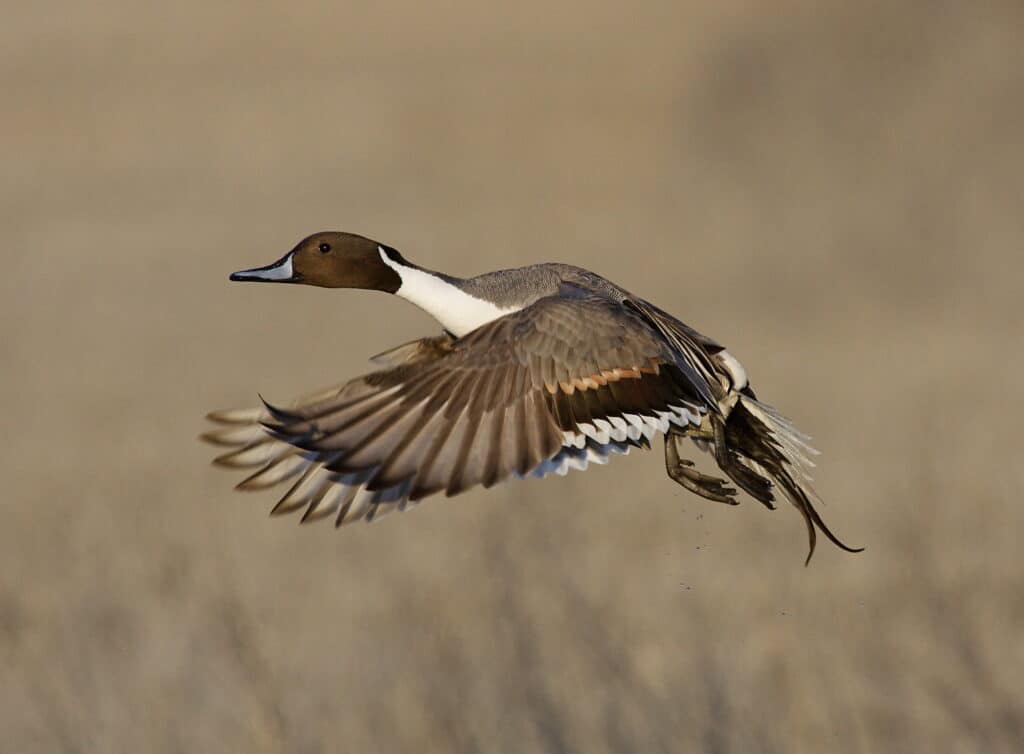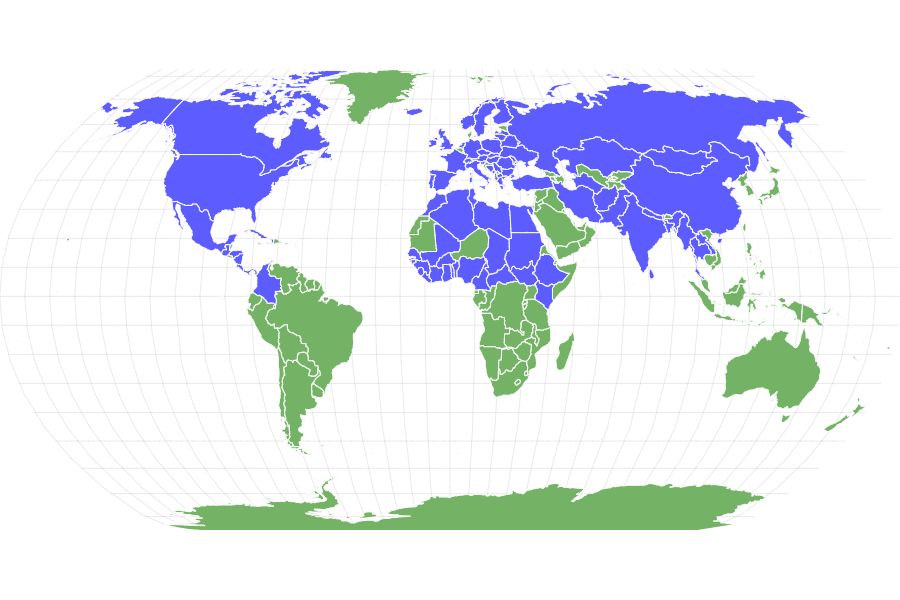Northern Pintail
Anas acuta
Northern pintails migrate at night with speeds reaching 48 miles per hour!
Advertisement
Northern Pintail Scientific Classification
- Kingdom
- Animalia
- Phylum
- Chordata
- Class
- Aves
- Order
- Anseriformes
- Family
- Anatidae
- Genus
- Anas
- Scientific Name
- Anas acuta
Read our Complete Guide to Classification of Animals.
Northern Pintail Conservation Status
Northern Pintail Facts
- Group Behavior
- Social
- Fun Fact
- Northern pintails migrate at night with speeds reaching 48 miles per hour!
- Estimated Population Size
- 5.1 million
- Wingspan
- 34 inches
View all of the Northern Pintail images!
Northern Pintail Summary
“Northern pintails migrate at night with speeds reaching 48 miles per hour!”
The northern pintail is a species of dabbling duck native to the majority of the world. Despite having such a large range of migration, there are no known geographical subspecies. They are known for their long necks and tails. It is not uncommon to find large groups of northern pintails flocking together.
Northern Pintail Amazing Facts
- One northern pintail once traveled 1800 miles nonstop.
- They will forage and swim with other groups of ducks and waterfowl.
- Their habitat may vary based on the time of day.
Where to Find Northern Pintail
The pintail is common in North America, Europe, Africa, and Asia. They can also be found in the northwesternmost region of Colombia.
During the breeding season, pintails flock together in Canada as well as the northernmost regions of the United States and Europe. This includes countries such as Sweden, Russia, and Denmark. Outside of the breeding season, you can find them throughout North America, excluding Canada, Colombia, western Europe, the central regions of Africa, and the southern regions of Asia.
This species of duck thrives in a variety of habitats. Overall, however, they prefer rather open areas with water. This includes wetlands, wet meadows, and agricultural fields. They may also breed in grasslands and other areas with short vegetation. Outside of the breeding season, once they move further south, you can find northern pintails in lakes, estuaries, and bays, along with wetlands and agricultural fields.
Although they may be seen swimming with other species of waterfowl, you can also expect to see flocks of pintails foraging along the shallow water they inhabit.
Northern Pintail Nests
Northern pintails nest on the ground. During the breeding season, both the male and female of the breeding pair will search for the right nesting location via flight. This includes seasonal wetlands and even tilled croplands, which are rare settings for different species of ducks.
Once the pair have decided on the right place to build their nest and rear their offspring, the female begins constructing the nest. She digs into the ground to create a small depression. She will then begin to add grasses to create a shallow nest. Once finished, the pintail’s nest is up to ten inches wide, and it is around two to four inches deep.
Northern Pintail Scientific name
The scientific name for the northern pintail is Anas acuta, as first described by Carl Linnaeus in 1758. Both words are of Latin origin, with anas meaning ‘duck’ and acuta meaning ‘sharp.’ As a result, their scientific name refers to their elegant, elongated appearance and the male’s pointed tail feathers.
The pintail is in the Class Aves, and they are a part of the Order Anseriformes along with all other waterfowl. They are in the Family Anatidae, which includes ducks, geese, and swans.
Northern Pintail Size, Appearance, and Behavior
The pintail is a medium-sized duck, one that is larger than a green-winged teal but smaller than a mallard. Adults of both sexes can grow to be between 20.1 to 29.9 inches in length. Their wingspan is only slightly larger than their body length at 34 inches from wingtip to wingtip. Adults can vary greatly in weight depending on their size, habitat, and diet. Most adults average between 17.6 and 51.1 ounces.
Northern pintails are known for their long necks and slim facial profiles. They have a sleek, sloped beak that is black. In both sexes, the tail is long and comes to a defined point, although the latter is more noticeable in males of the species rather than females. Breeding males have a chocolate-brown colored head with a bright white chest and neck marking. Their green speculum is visible in flight, though it is bronze in females. Both sexes sport a grey and white back, although females and males that are undergoing the molting process will sport an unmarked grey or tan face instead of the male’s striking brown plumage.
As dabbling ducks, pintails can often be seen floating along the surface of the water. When hunting, they will duck their heads into the water, leaving their tail feathers in the air. Out of the water, they can be seen waddling along the edge of their preferred water source. Northern pintails readily form large flocks with each other, as well as with members of other species outside of the breeding season.
As social birds, confrontation is rare. However, males may break out into occasional fights involving a pecking attack and chasing on the water’s surface.

Male northern pintails have a notable, dark brown head.
©Tom Reichner/Shutterstock.com
Northern Pintail Migration Pattern and Timing
Northern pintails will migrate to and from their breeding grounds in large groups. In the sky, they make a notable wavy line. They are long-distance migrants, spending their breeding summers in the far north of the North American continent and the rest of the year in the southern regions. This is also true for other continents, where they breed in the same period before migrating to the south. One individual once migrated and traveled 1800 miles without stopping.
Not only are they a long-distance migratory species, but they are also a rapid migrator. They are one of the first species of ducks to migrate south to the winter region during the appropriate time following the summer breeding season.
Northern Pintail Diet
This species is made up of omnivores. As dabbling ducks, they dip their heads into the water to skim for small animals. They will also eat different types of plants and plant parts. These are often picked up while the northern pintail is walking, although they may also eat aquatic plants in shallower areas.
What Do Northern Pintails Eat?
Northern pintails are not apex predators. However, they are still effective hunters with a wide variety of prey. Some of the animals that northern pintails will eat include:
- Worms
- Snails
- Crustaceans
- Insects
As for the plant matter aspects of their diet, northern pintails eat:
- Rice
- Wheat
- Corn
- Barley
- Aquatic native plants
- Grasses and seeds
Northern Pintail Predators and Threats
One of the largest threats to the pintail population is avian diseases. These conditions, such as avian botulism, can cause significant decreases in population, especially in the United States.
These species may also become prey to a variety of different predators.
What Eats Northern Pintails?
Living both inland and on water, the pintail, as well as their young, may be exposed to a variety of different predators. Some of the animals that may eat the pintail include:
- Foxes
- Hawks
- Snakes
- Coyotes
- Skunks
Northern Pintail Reproduction, Babies, and Lifespan
The female northern pintail will produce one brood per year. However, the male may also breed with other females nearby in their breeding territory despite forming a breeding pair with a specific female. Pairs will only stay together for the breeding season. Each brood can contain between three and twelve eggs. These eggs are rather large in size compared to other birds, with some measuring over two inches in length.
Incubation of these eggs takes between 22 and 24 days. Once the young northern pintails, known as ducklings, hatch, they are covered in down. Often, they are able to leave the nest soon after they emerge from their eggs.
The northern pintail can live to be up to 22 years old. They molt in the late summer as adults, rendering them flightless.
Northern Pintail Population
The northern pintail is listed as a species of least concern despite significant declines in their populations in recent decades. There is a global breeding population of around 5.1 million.
View all 65 animals that start with NNorthern Pintail FAQs (Frequently Asked Questions)
Does the northern pintail migrate?
Yes, the northern pintail migrates prior to and after the breeding season.
How many eggs does the northern pintail lay?
They lay between 3 and 12 eggs.
How fast does the northern pintail fly?
Up to 48 miles per hour.
What is the northern pintail's wingspan?
They have a wingspan of 34 inches.
When do northern pintails leave the nest?
They are born in down and leave shortly after hatching.
Thank you for reading! Have some feedback for us? Contact the AZ Animals editorial team.
Sources
- , Available here: https://www.jstor.org/stable/3784102

















